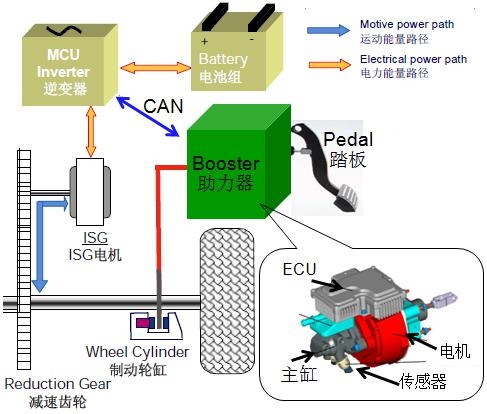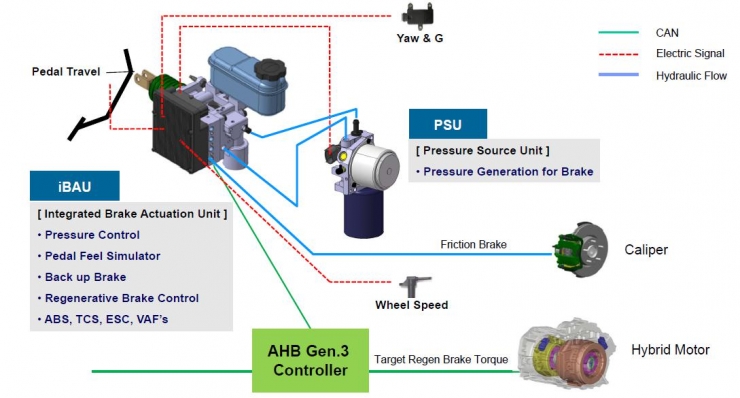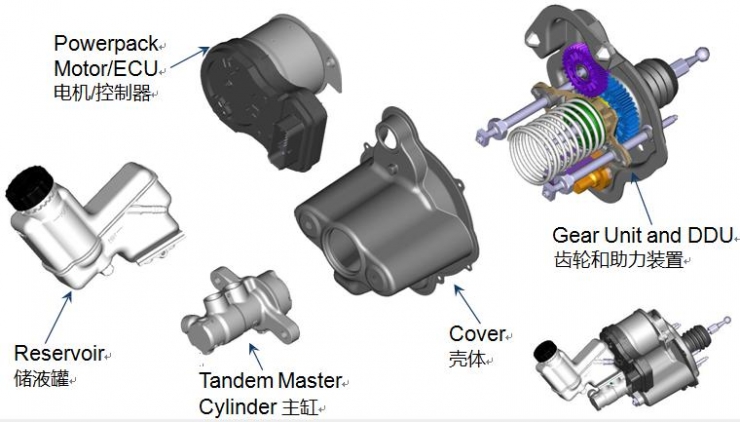Lei Feng Network (search "Lei Feng Network" public concern) by: The author of this article is Xiao Peng automotive engineers team.
Brake energy recovery, for electrically driven vehicles, means that during the deceleration or braking process, the drive motor operates in a state of power generation, and converts part of the vehicle's kinetic energy into electrical energy for storage in the battery . At the same time, the motor feedback torque is applied to the drive shaft to brake the vehicle. This braking method is called Regenerative Braking or feedback braking.
The application of braking energy recovery technology on electric vehicles can increase the cruising range of the vehicle on one charge.
The braking energy recovery is completed by the electric braking system and the hydraulic braking system. The hydraulic brake system is the key actuator of the brake energy recovery system. Its task is to control the brake pressure to ensure the driver's good brake pedal feel and ensure the brake safety of the vehicle. The hydraulic braking system of the braking energy recovery system of electric vehicles is different from the braking system of traditional fuel vehicles. On the one hand , it shows that the electric vehicle does not provide the vacuum for the braking system with the traditional internal combustion engine, and on the other hand, it shows the recovery of braking energy. Implementation requires a signal exchange between the hydraulic brake system and the motor .
Based on the technical requirements put forward by the regenerative braking system, major auto manufacturers and parts and components companies have introduced hydraulic brake systems with brake energy recovery that are applicable to different types of electric vehicles. Next we talk about several typical solutions in the industry.
1. Hydraulic brake system based on vacuum assist
"Vacuum booster + vacuum pump" solution
The program is mainly to add EVP (Electronics Vacum Pump), PTS (Pedal Travel Sensor) and pressure sensor in the original vacuum booster hydraulic brake system.
The role of the EVP is to provide a power source for the vacuum booster because the electric drive passenger car does not have a conventional engine and cannot provide vacuum for the vacuum booster. The vacuum booster cannot provide brake boost without vacuum. The system will usually also have a vacuum tank for storing a certain volume of vacuum, making the system more stable vacuum, while reducing the EVP start frequency, increasing EVP service life. PTS is mainly used to provide brake signals to motor controllers, effectively utilize brake air stroke for energy recovery, and increase energy recovery.
The advantage of this system is that most of the parts of the original brake system can be used, the implementation is convenient, the technology is mature, the system is stable, and the cost is low. The main disadvantages are that the motor feedback braking force is directly superimposed on the original friction braking force, the original friction braking force is not adjusted, the energy recovery rate is low, and the braking comfort is poor. The poor braking comfort is not only reflected in the coupling and switching of motor feedback braking and friction braking, but also caused by the poor smoothness of the transition. It is also manifested in the plateau region. Due to the low pressure, EVP cannot provide the same high vacuum as in plain areas. Vacuum booster poor assistance, pedal force will increase.
2. Hydraulic brake system based on ESP/ESC Bosch ESPhev solution
Bosch ESPhev solution
Taking Bosch's ESPhev as an example, the system does not need vacuum booster and EVP, and is based on the original ESP technology. In addition to the standard functions, ESP adds conventional brake hydraulic power assistance functions and feedback torque coordination functions . The ESP calculates the driver's braking demand based on the PTS signal in the BOU (Brake Operating Unit), and then distributes the braking force based on the feedback braking force provided by the motor and the stability of the integrated vehicle. The brake system pressure is provided by the ESP.
The system has a smaller installation size than the traditional braking system, a lighter weight, can coordinate the feedback torque and hydraulic torque, and has a high energy recovery rate. However, the front axle of the system is decoupled, and the brake pipe is of type II arrangement, which is different from the common X type arrangement, and this solution is only applicable to small cars (with a full load of not more than 1700 kg).
3. Hydraulic brake system based on EHBEHB (Electronics Hydraulic Brake, electrohydraulic brake system) consisting mainly of power units (motors, pumps and accumulators), hydraulic units (master cylinders, pedal simulators and PTS) and electronic control units, via brake lines And the control valve is connected with the brake wheel cylinder to control the brake fluid flow into/out of the brake wheel cylinder, so as to achieve brake pressure control .

Bosch HAShev solution
The picture above shows Bosch's HAShev system. The system is mainly composed of BOU, ACM-H (Actuation Control Module - Hydraulic, hydraulic assistance control module) and ESP. BOU with PTS, used to detect the driver's braking needs; BOU and brake pedal is decoupled, integrated pedal simulating device, pedal sensation simulator is mainly a spring damping mechanism, can be flexible to adjust the pedal feel. ACM-H is mainly composed of electric hydraulic pump, high pressure accumulator and electronic control unit. Its task is mainly to supply energy to the hydraulic brake system, and is also responsible for coordinated control of feedback torque and hydraulic torque . The system's ESP has more active boost than the conventional ESP. It can actively pressurize the ACM-H when it fails to ensure safe braking. At the same time, there is feedback between the ESP and the motor control unit and the ACM-H. Torque, vehicle stability factors and other signal interactions.
The system pedal decoupling, pedal sense can be flexibly designed to dynamically control the coordinated distribution of the motor feedback torque and hydraulic braking torque, priority use of regenerative torque to achieve maximum efficiency of braking energy recovery ; at the same time it has a strong failure mode, ACM- ESP can compensate when H fails, and the mechanical structure ensures safety when the hydraulic pressure fails. However, there are many parts and components in the system and the structure is complex. Four brake pipes need to be added. The weight is not advantageous, and the commissioning and maintenance costs are high.
 Mando AHB III Solution
Mando AHB III Solution
The picture above shows the AHB III scheme of South Korea's Mando Company, which consists of iBAU (Integrated Brake Actuation Unit) and PSU (Pressure Source Unit). Compared with Bosch's HAShev system, Mando integrated the electronic control unit and ESP/ESC in the iBAU, reducing the number of components, making it more flexible and lighter in weight and lighter than 2 kg. Moreover, iBAU performs wheel pressure control directly to eliminate system losses to the greatest extent and enhance pressure controllability.
4. Hydraulic brake system based on new brake booster
New brake booster based solution
This solution has no vacuum booster and EVP, no hydraulic pump or accumulator, and instead uses a high-performance motor that drives the piston in a linear motion through a gear mechanism to produce the master cylinder pressure. Compared with the ordinary braking system, it is more lightweight, the system responds more quickly, can significantly increase the pressure build-up speed, effectively shorten the braking distance, and meet the higher requirements of the new advanced driver assistance system on the dynamic characteristics of brake pressure control. Coordinated regenerative braking functions are similar to those based on ESP/ESC and EHB technologies and can also achieve efficient braking energy recovery.
The brake pedal of the system can also be decoupled. There is no direct connection between the build-up pressure process and the brake pedal. The pedal feel is generated by a spring/buffer unit integrated in the actuator module. The sense of pedal can be adjusted according to the requirements of the vehicle. It can also be adjusted individually according to different driving situations (such as emergency braking) or operating modes (such as "sports"). It can realize regenerative braking without any additional measures. The perfect unity of comfort.
This scheme has been successfully applied to Nissan Leaf, Tesla Model S and Alfa Romeo Giulia.

Continental Group's MK C1 (with ESC integrated)

Bosch ibooster (without integrated ESP/ESC)
Compared with the traditional brake system products, the current EHB or new brake booster and other products are still relatively expensive to develop, but as the technology continues to advance, these development costs will continue to decrease. We believe that braking systems will gradually move toward lightweight, modular, and intelligent EHBs or new types of brake boosters.
At present, foreign major brake system component suppliers (such as Bosch, TRW, Continental, Aidex, Hitachi, Vanguard, etc.) have launched their own EHB or new brake booster products, and our domestic suppliers are There are short boards in the development and manufacturing of key components such as traditional chassis electronic control systems ESP/ESC/EHB and solenoid valves . There is still a gap between the development of EHB or new brake booster products and foreign ones . However, domestic research and development in this area have also made some progress. For example, electronic hydraulic boosters and electronic vacuum boosters have formed products. Many domestic suppliers are cooperating with some universities and have achieved good results through cooperation between production, education and research. progress. With the gradual advancement of the industrialization of electric vehicles, it is believed that domestic suppliers can also develop products such as EHB or new type of brake booster that meet the needs of the entire vehicle, and form the ability to compete with similar foreign standards.
Reference materials
1. Zhang Junzhi, Lu Chen, Li Yu, Yan Jinfang, He Chengkun. The status quo and outlook of the development of brake energy recovery technology for electric drive passenger cars. Automotive Engineering, 2014(08).
2. Zhang Hongsheng. Car electronically controlled hydraulic braking system performance analysis and control. Nanjing University of Aeronautics and Astronautics, 2013.
3, Huang Xia. Car electronically controlled hydraulic braking system performance analysis and control. China Automotive News Network, 2016-07-13.
Lei Fengwang Note: This article published by Xiaopeng Automobile Lei Feng network, reproduced please contact the authorize and retain the source and the author, not to delete the content.